This article originally appeared on Counterpunch.
In a recent May 29 Bend Bulletin article, Senator Merkley asserted he “wants to boost spending on forest management by $1 billion annually through work, such as thinning and prescribed burning, to reduce the prospects of catastrophic wildfires.”
An unexamined assumption is that thinning/logging work significantly reduces the pejoratively named “catastrophic” fires.
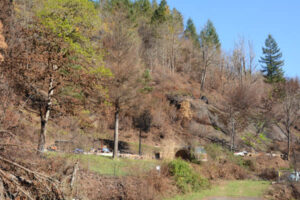
The Holiday Farm Fire burned the western slopes of the Cascades driven by extreme fire weather conditions, including high winds, charred acres of clearcuts, and other “fuel reductions.” Photo George Wuerthner.
Despite assertions from the Forest Service and others who will gain financially from inflated budgets to log our forests, one needs to ask if “fuel reductions” work to halt wildfires when burning under extreme fire weather conditions. That qualifier is important. All large blazes, like those that charred the western Cascades last Labor Day, burn swiftly through logged sites and other “fuel reductions.”
All such blazes occur under drought conditions, high temps, low humidity, and high winds. Thinning/logging and prescribed fires will not significantly preclude large blazes burning under extreme fire weather conditions.
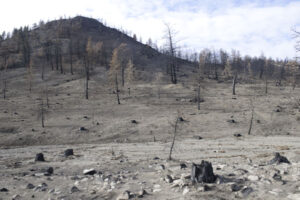
This fire in the Scratchgravel Hills by Helena, Montana, driven by 50 mph, burned through this forest that had been thinned just six months prior to the blaze. Photo George Wuerthner.
I have traveled extensively around the West to view the aftermath of the largest fires, and every single one occurred during extreme fire weather conditions. Nothing, including thinning, logging, and prescribed burns, works to contain such fires when you have these conditions. I know of no exceptions.
Such blazes are only contained when the weather conditions change. Logging does not change the weather.
When it “appears” that fuel reductions worked under extreme conditions, you need to examine the actual burn circumstances during the blaze—the intensity of fire changes hour by hour.
Proponents of forest thinning, including Merkley, suggest previous thinning projects saved Sisters, Oregon from the 2017 Milli Fire that burned within 2-3 miles of town. Yet if you read the Fire Incident Report carefully, such conclusions are questionable.
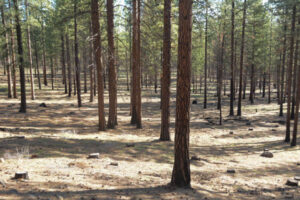
Thinned ponderosa pine stand near Sisters, Oregon, has resulted in a mono-culture of nearly even-aged forest that degrades the forest ecosystem and doesn’t stop fires burning under extreme fire weather. Thinning kills trees to preclude natural processes from killing trees. Photo George Wuerthner.
The Milli Fire burned through two previous burns (Pole Creek and Black Crater), presumably “fuel reductions.” It also burned through some thinned stands before thinning “saved” Sisters.
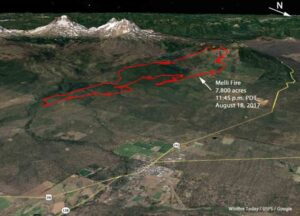
The red outline shows the wind-driven effect of the Milli Fire. A change in wind direction “saved” Sisters—photo USFS.
What happened is that the wind that had been moving the fire towards Sisters shifted, pushing the fire west and north into lava fields in the Three Sisters Wilderness.
Did thinning save Sisters? Maybe? However, a more nuanced analysis might conclude that a change in weather patterns is what “saved” Sisters.
Worse for our communities is that the Forest Service is “selling” a myth. Thinning/logging has been shown to increase fire spread. Thinning opens the forest to more wind penetration and more soil drying—both factors are conducive to fire spread during extreme fire weather.
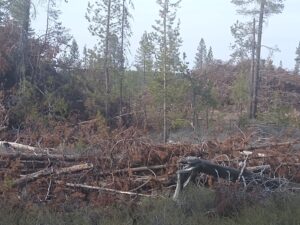
Logging/thinning on the Deschutes NF leaves many fine fuels on the ground, often exacerbating fire spread. Photo George Wuerthner.
What burns in wildfires are the fine fuels: grass, shrubs, pine needles, small trees, and so forth. Large trees that thinning removes typically do not burn. That is why we have “snags” after a severe fire.
While thinning and prescribed burning treatments might lower fire intensity briefly immediately after the treatment, the chances that a fire will encounter a treatment is extremely rare.
Ironically, fuel reduction often increases the percentage of fine fuels on a site, ensuring that a blaze can readily spread if driven by high winds.
Ignored in the race to log our forests is that high severity fires are essential to healthy forest ecosystems. The biodiversity they produce often exceeds what is found in “green forests.”
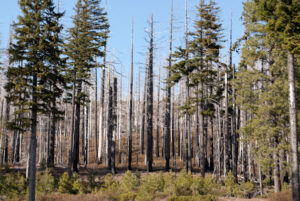
Snags are critical to a healthy forest ecosystem. This is a sign of forest “health.” Photo George Wuerthner.
So the “story” the FS sells that thinning is “improving” forest health is another inaccurate statement. Dead trees resulting from fires, bark beetles, and other natural factors are critical to healthy forest ecosystems.
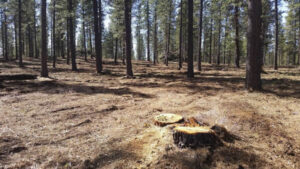
A sanitized forest stand (restoration) on the Deschutes NF, Oregon. Note the lack of small trees, lack of species diversity, lack of snags, down wood, and even shrubs. Photo George Wuerthner.
Thinning/logging is not benign. There are many impacts to the forest ecosystem from “restoration,” “fuel reductions,” and other euphemisms used to justify commercial logging. These include the spread of weeds, sedimentation in streams from logging roads, displacement of sensitive wildlife, loss of biomass, and loss of carbon storage.
Ultimately, we must deal with the GHG emissions that drive climate change, increasing drought, variable weather, and the conditions that favor large blazes.
In the meantime, increasing thinning and prescribed burning, except in the immediate area around communities, does little to protect homes. A much better way to spend scarce funds is to assist communities and homeowners in reducing the flammability of homes, burying power lines, and precluding new home construction in fire-prone areas.
George Wuerthner has published 36 books including Wildfire: A Century of Failed Forest Policy. He serves on the board of the Western Watersheds Project.


The most important book that George Wuerthner ever wrote was Sacred Cows at the Public Trough, showing the massive ecological and environmental harms caused by cattle & sheep grazing (mainly cattle), and that the grazing industry caused more ecological and environmental harm in the western U.S. than any other industry. George is an old fellow Earth First!er from the 1980s and does great work.
As to forest fire issues, there is one factor that George isn’t considering here. There are forests that are unnaturally dense because of unnatural fire suppression that white people did at the behest of the tree-killing industry. When fire strikes these unnaturally dense forests, it burns hotter and bigger than it would naturally because of the unnatural density. (And BTW, the National Deforest Service allows cattle grazing in the forests, doing additional harm.) The unnatural density is mostly brush and grass, and that needs to be thinned back to natural levels, but the same goes for unnaturally dense trees.
Another problem in our grossly overpopulated and unnaturally-living world is that most forest fires are started by humans, not by natural events like lightning, and human-caused fires are very destructive.
As to killing vegetation around homes: if you can’t live in or adjacent to a forest without killing the plants that live there, then don’t live there. People shouldn’t be killing trees or plants because they’re close to people’s homes and people are afraid of forest fires.
The rest of this column is spot on. Natural wildfires are, well, natural, and they are necessary for ecosystem health because these forests evolved with them. It doesn’t matter whether forest thinning “works” for the desired result, because it doesn’t work for the forest itself and everything that lives there. George makes a great utilitarian argument for why people shouldn’t thin forests, but the moral reason is that people should only kill what they eat (with the lone exception being the restoration I mentioned above), and we don’t eat trees.